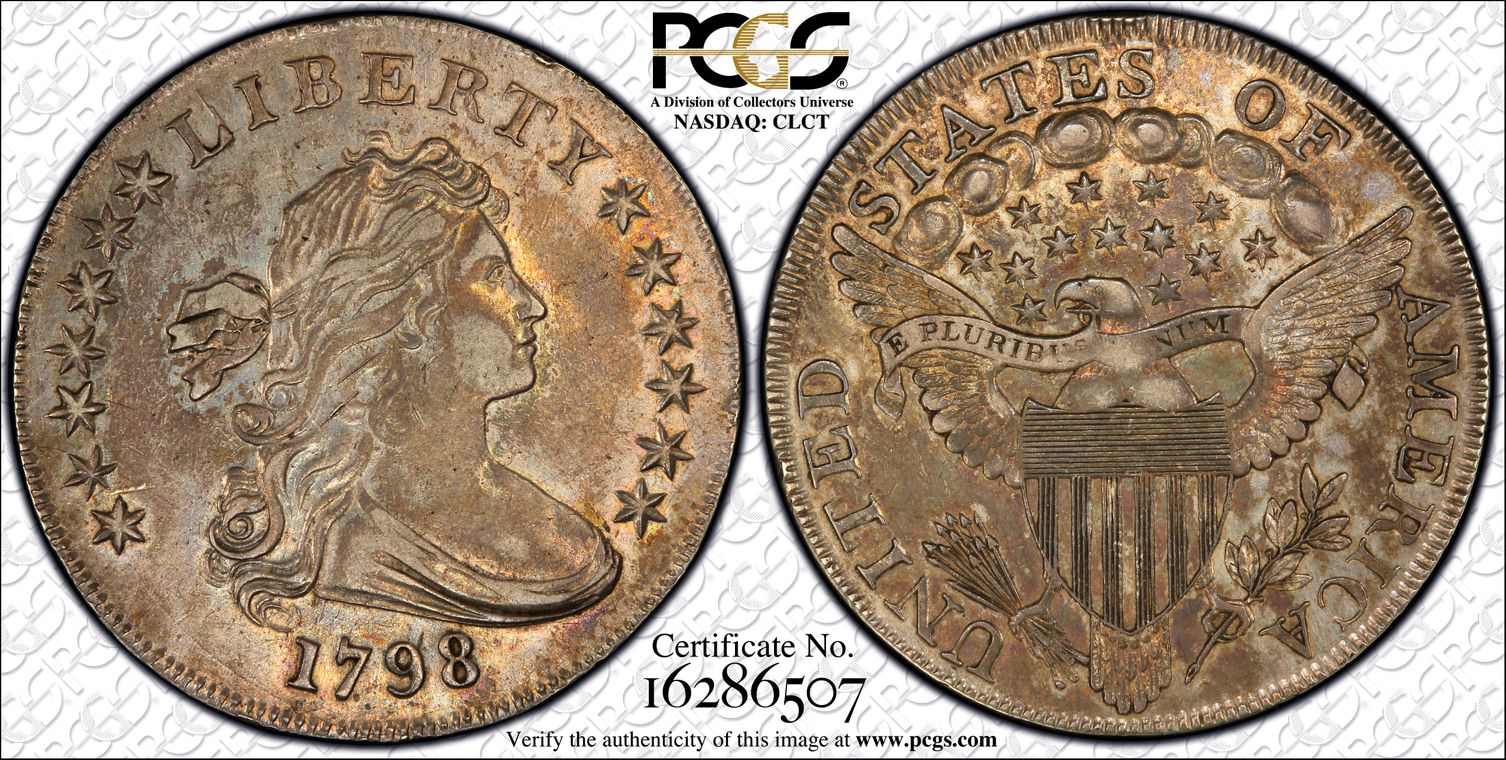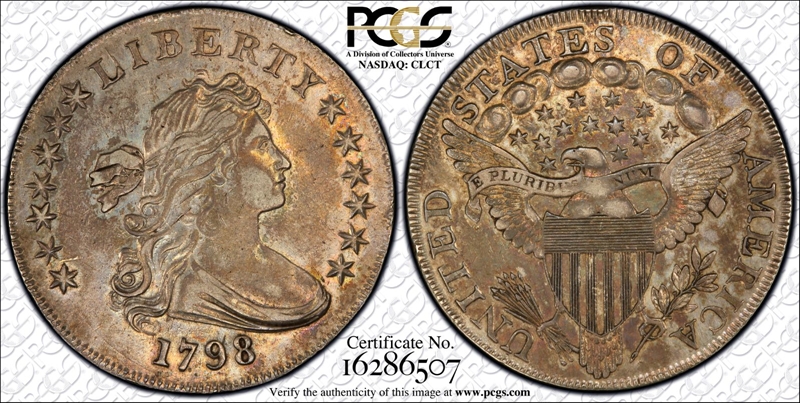1798 $1 BB-109 XF45 认证号16286507, PCGS号40026
拥有者评论
B-10 BB-109. Arc star pattern on reverse. PCGS EF45 (CAC). This coin has an amazing strike. BB-109 is usually always weak in the center on both obv. and rev. This coin should easily be qualify for mid CC Est.Pop.40-100 coins. R-5.
专家评论
Q. David Bowers
The following narrative, with minor editing, is from my "Silver Dollars & Trade Dollars of the United States: A Complete Encyclopedia" (Wolfeboro, NH: Bowers and Merena Galleries, Inc., 1993). Note: the Notable Specimens list should be used with caution - it has been updated in my 2013 edition of "The Encyclopedia of United States Silver Dollars 1794-1804."B-10. H-10.
OBVERSE 9: See description under 1798 BB-108. Obverse die used to strike BB-108 (early and late states) and 1798 BB-109 (intermediate state; 1798 BB-109, Die State III).
REVERSE J: Five small berries, the 'two upper-most being closest together. Arc star pattern. Star slightly distant from eagle's beak; star ray points to center of B of PLURIBUS. 13 perfect arrows, some formed better than others. Leaf points to just left of center of upright of! in AMERICA. A die flaw (chip out of die) under end of stem. Berry under right foot of A in AMERICA (compare to the reverse of BB-111, with the berry under the left foot). All specimens seen are lightly struck on the eagle.
Note: As the obverse was used later to coin more 1798 BB-108s, one wonders what happened to this reverse die. Why was its use interrupted? Perhaps, somewhere "out there" is a BB-109 exhibiting a sudden, massive reverse die failure (this note is per the observation of Harry E. Salyards, M.D., letter to the author, January 19, 1993.)
Reverse die used to strike 1798 BB-109 only.
DIE STATES:
Die State I: Obverse die without crack from right side of L in LIBERTY. May not exist.
Die State II: Obverse die with crack from right side of L in LIBERTY; without lower obverse cracks. This die state was used to coin early examples of 1798 BB-108; may not exist with BB-109.
Die State III: Obverse with die crack upward from right portion of L in LIBERTY. Light die crack from border under 7 of date to left through several stars. Centers weak. The die state usually seen.
Die State IV: Centers even weaker than the preceding. Die cracks more advanced. Not seen.
COLLECTING NOTES: 1798 BB-109 is another scarce issue. I estimate that 75 to 125 exist, nearly all of which are in lower grades. Opinions concerning the rarity of this variety have been the subject of debate. Bolender suggested Rarity-4 (76 to 200 known, if he used the Sheldon Scale), which may be correct at the rarer end of the spread. Others have suggested that fewer than 30 exist. BB-109 is always weakly struck on the eagle and at the center of the bust.
NOTABLE SPECIMENS:
Boyd Specimen. AU-55. World's Greatest Collection, F.C.C. Boyd, Numismatic Gallery, 1945:35. "The die shows slight wear on reverse. A splendid Uncirculated example."
1976 ANA Convention Sale Specimen. AU-55. Stack's, ANA Convention Sale, 1976:1332. "AU and choice. Full frosty mint lustre. Actually the cataloguer feels that the coin never saw circulation, but the slightly convex shape makes the centers higher than the rims and some rubbing occurred."
Earle Specimen. AU-50. George H. Earle Collection, Henry Chapman, 1912. Col. E.H.R. Green Collection. M.H. Bolender Collection, Bolender, 1952:51." Obverse practically Uncirculated, beautiful impression. Reverse EF. Mint lustre."
Von Stetten-Buchenbach Specimen. VF-35. Bowers and Merena, 1986:1949. "VF-35 to EF-40, cleaned, but not in a detracting manner. A sharp and bright piece with gray toning in protected areas."
Baldenhofer Specimen. VF-30. W.G. Baldenhofer, to Stack's Farish-Baldenhofer Sale. AJ. Ostheimer, 3rd Collection. ANA Convention Sale, Superior, 1975:862. "Die break upward from right portion of L in LIBERTY. VF-30 where struck up. Dull gray and iridescent tone and clean, except for some edge bruises and nicks above LIBERTY."
Saunders Specimen. VF-30. Bowers and Merena, 1987:3510. "Value of VF-30, but actually EF-40 from a technical wear viewpoint. Some mint lustre still remains in protected areas. The coin is struck ever so slightly off-center, with the result that the denticles and protective rims on the reverse are very well pronounced at the top but are absent at the bottom. A same situation is true for the obverse, but to a lesser extent."
PCGS #
40026
设计师
Robert Scot
边缘
Lettered: HUNDRED CENTS ONE DOLLAR OR UNIT
直径
40.00 毫米
重量
27.00 克
铸币数量
287536
金属成分
90% Silver, 10% Copper
更高评级数量
1
评级较低的钱币数量
5
地区
The United States of America
价格指南
PCGS 数量报告
拍卖 - PCGS 评级的
拍卖 - NGC 评级的






















